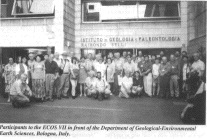|
|
two breasts, but some represent an
androgynous condition and only have one.
Thelast day took us back to SW
Sardinia. The first stop in the Upper
Ordovician of Cannamenda was to two
trenches which exposed the Punta S Argiola
Member of the Domusnovas Formation. The
richest Ordovician conodont fauna in Sardinia
is found here, but only, to quote the
guidebook, in the thin fossiliferous horizon (4-
4.5cm) with no lateral continuity and poorly
exposed as small sparse pieces in the field.
The only redeeming feature is its distinctive
pink colour.
We returned again to the Devonian.
Of all the outcrops we visited, this was the
most unconvincing, in that it appeared to be a
loose block set in the hedge between two
fields. Nevertheless, important conodonts
have been collected, representing the only
Middle and Late Devonian faunas collected in
SW Sardinia.
There was a final look at the Silurian
OrthocerasLimestone before we slippedinto
the Cambrian Gonessa Formation for a spot
to eat. The venue - a restaurant next to an
enormous cave; lunch (ample cold meat, anti-
pasta and suckling pig) had an added bonus -
our first taste of famous Italian ice cream.
Absolutely mouth-watering!
After lunch Cambrian material was
collected from the roadside. The last part of
the day was spent travelling around the
spectacular coast of SW Sardinia. The Sardic
Unconformity, described by Cocozza as the
most beautiful in the world, and to this day
known to Italians as "La Discordanza", was
our last stop. Upper Cambrian laminated
shales (Cabizta Formation) are overlain by
boulder-bearing conglomerates of the
Ordovician Monte Argentu Formation, an
unconformity definitely as spectacular as any
I have seen. The return to Senorbí heralded
another huge meal. The main course fish had
interesting crushing dentition, some of which
was dissected by Phil Donoghue. The after
dinner entertainment arrived in the form of a
joke-telling session chaired and dominated by
Rocco Repetski, with encouragement from
Dick Aldridge and Andrew Simpson.
Our last day began with Ordovician
localities, and some of the steepest walks of
the week; not necessarily a bad thing after all
the eating! The outcrops at Umbrarutta yield
the best -preserved Ordovician faunas found
in Sardinia, so last samples were collected,
and we finished the geological part of the field
trip. We then headed west to the
archaeological ruins of Tharros, grabbing a
last chance to do some geology by studying
basaltic blocks used in its construction.
The final seafood meal was fantastic
and the wine flowed freely. Dick Aldridge gave
the speech of thanks to the organising
committee aided and abetted by Norman
Savage's helpful suggestions. We all heartily
agreed that the trip had been an enormous
|
|
|
|
success, and
organisers.
|
|
raised
|
|
|
our
|
|
glasses
|
|
|
to
|
|
the
|
|
|
|
|
|
|
The scientific sessions for the 7th
International Conodont Symposium in Europe
(ECOS VII) took place at the University of
Bologna (claimed as the world's oldest) in the
Dipartimento di Scienza della Terrae
Geologico-Ambiantale.
Congress President, Professor
Enrico Serpagli, noted the large number of
participants (109 from 27 nations), many who
had dipped into their own pockets, despite
the generally gloomy global picture of
declining funding for palaeontological
research. During the welcome we were
reminded that the University has a proud
tradition of stratigraphic research in the
Carnic Alps and the Dolomites, dating back to
Pollini last century. The University was also
the site of the 2nd International Geological
Congress in 1880. There is obvious pride in
the Department's Geological and
Palaeontological Museum (visited by
delegates the previous evening), that houses
a fully reconstructed Diplodocus. The
museum was only recently saved from
extinction and opened to the public in 1988.
The President of the Italian Palaeontological
Society reiterated the words of welcome, and
noted that despite technological and
geochemical advances, fossils are still
needed for accurate and viable age
determinations.
Dick Aldridge (Univ. Leicester),
presented the invited lecture on conodont
palaeobiology, reviewing the developing
concepts and summarising current knowledge
since the discovery of the whole animal in a
museum draw in the early 1980s. He noted
|
|


 1
2
3
4
5
6
7
8
9
10
11
12
13
14
15
16
17
18
19
20
21
22
23
24
25
26
27
28
29
30
31
32
33
34
35
36
37
38
39
40
41
42
43
44
45
46
47
48
1
2
3
4
5
6
7
8
9
10
11
12
13
14
15
16
17
18
19
20
21
22
23
24
25
26
27
28
29
30
31
32
33
34
35
36
37
38
39
40
41
42
43
44
45
46
47
48



 1
2
3
4
5
6
7
8
9
10
11
12
13
14
15
16
17
18
19
20
21
22
23
24
25
26
27
28
29
30
31
32
33
34
35
36
37
38
39
40
41
42
43
44
45
46
47
48
1
2
3
4
5
6
7
8
9
10
11
12
13
14
15
16
17
18
19
20
21
22
23
24
25
26
27
28
29
30
31
32
33
34
35
36
37
38
39
40
41
42
43
44
45
46
47
48

